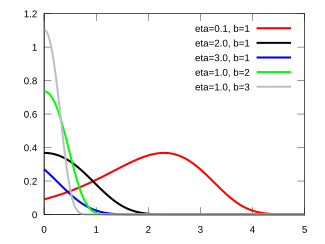Continuous probability distribution, named after Benjamin Gompertz
Gompertz distribution|
Probability density function  |
|
Cumulative distribution function  |
| Parameters |
shape  , scale , scale  |
|---|
| Support |
 |
|---|
| PDF |
 |
|---|
| CDF |
 |
|---|
| Quantile |
 |
|---|
| Mean |

 |
|---|
| Median |
![{\displaystyle \left(1/b\right)\ln \left[\left(1/\eta \right)\ln \left(1/2\right)+1\right]}](https://wikimedia.org/api/rest_v1/media/math/render/svg/b2025ab32684a86966829b308bb1452815fe57bf) |
|---|
| Mode |


 |
|---|
| Variance |
 ![{\displaystyle +\left(\pi ^{2}/6\right)+2\gamma \ln \left(\eta \right)+[\ln \left(\eta \right)]^{2}-e^{\eta }[{\text{Ei))\left(-\eta \right)]^{2}\))](https://wikimedia.org/api/rest_v1/media/math/render/svg/0850883c7b5814914301c155e014ceb896b962b7)
 ![{\displaystyle {\begin{aligned}{\text{ and )){}_{3}{\text{F))_{3}&\left(1,1,1;2,2,2;-z\right)=\\&\sum _{k=0}^{\infty }\left[1/\left(k+1\right)^{3}\right]\left(-1\right)^{k}\left(z^{k}/k!\right)\end{aligned))}](https://wikimedia.org/api/rest_v1/media/math/render/svg/119de9d74e9e1513410d20f25e74f7b7336a0948) |
|---|
| MGF |

 |
|---|
In probability and statistics, the Gompertz distribution is a continuous probability distribution, named after Benjamin Gompertz. The Gompertz distribution is often applied to describe the distribution of adult lifespans by demographers[1][2] and actuaries.[3][4] Related fields of science such as biology[5] and gerontology[6] also considered the Gompertz distribution for the analysis of survival. More recently, computer scientists have also started to model the failure rates of computer code by the Gompertz distribution.[7] In Marketing Science, it has been used as an individual-level simulation for customer lifetime value modeling.[8] In network theory, particularly the Erdős–Rényi model, the walk length of a random self-avoiding walk (SAW) is distributed according to the Gompertz distribution.[9]
Specification
Probability density function
The probability density function of the Gompertz distribution is:

where  is the scale parameter and
is the scale parameter and  is the shape parameter of the Gompertz distribution. In the actuarial and biological sciences and in demography, the Gompertz distribution is parametrized slightly differently (Gompertz–Makeham law of mortality).
is the shape parameter of the Gompertz distribution. In the actuarial and biological sciences and in demography, the Gompertz distribution is parametrized slightly differently (Gompertz–Makeham law of mortality).
Cumulative distribution function
The cumulative distribution function of the Gompertz distribution is:

where  and
and 
Moment generating function
The moment generating function is:

where

Properties
The Gompertz distribution is a flexible distribution that can be skewed to the right and to the left. Its hazard function  is a convex function of
is a convex function of  . The model can be fitted into the innovation-imitation paradigm with
. The model can be fitted into the innovation-imitation paradigm with
 as the coefficient of innovation and
as the coefficient of innovation and  as the coefficient of imitation. When
as the coefficient of imitation. When  becomes large,
becomes large,  approaches
approaches  . The model can also belong to the propensity-to-adopt paradigm with
. The model can also belong to the propensity-to-adopt paradigm with
 as the propensity to adopt and
as the propensity to adopt and  as the overall appeal of the new offering.
as the overall appeal of the new offering.
Shapes
The Gompertz density function can take on different shapes depending on the values of the shape parameter  :
:
- When
 the probability density function has its mode at 0.
the probability density function has its mode at 0.
- When
 the probability density function has its mode at
the probability density function has its mode at

Kullback-Leibler divergence
If  and
and  are the probability density functions of two Gompertz distributions, then their Kullback-Leibler divergence is given by
are the probability density functions of two Gompertz distributions, then their Kullback-Leibler divergence is given by
![{\displaystyle {\begin{aligned}D_{KL}(f_{1}\parallel f_{2})&=\int _{0}^{\infty }f_{1}(x;b_{1},\eta _{1})\,\ln {\frac {f_{1}(x;b_{1},\eta _{1})}{f_{2}(x;b_{2},\eta _{2})))dx\\&=\ln {\frac {e^{\eta _{1))\,b_{1}\,\eta _{1)){e^{\eta _{2))\,b_{2}\,\eta _{2))}+e^{\eta _{1))\left[\left({\frac {b_{2)){b_{1))}-1\right)\,\operatorname {Ei} (-\eta _{1})+{\frac {\eta _{2)){\eta _{1}^{\frac {b_{2)){b_{1))))}\,\Gamma \left({\frac {b_{2)){b_{1))}+1,\eta _{1}\right)\right]-(\eta _{1}+1)\end{aligned))}](https://wikimedia.org/api/rest_v1/media/math/render/svg/5f9b95f1a065a165b2d14d8e118ed769dc59be0d)
where  denotes the exponential integral and
denotes the exponential integral and  is the upper incomplete gamma function.[10]
is the upper incomplete gamma function.[10]










![{\displaystyle \left(1/b\right)\ln \left[\left(1/\eta \right)\ln \left(1/2\right)+1\right]}](https://wikimedia.org/api/rest_v1/media/math/render/svg/b2025ab32684a86966829b308bb1452815fe57bf)




![{\displaystyle +\left(\pi ^{2}/6\right)+2\gamma \ln \left(\eta \right)+[\ln \left(\eta \right)]^{2}-e^{\eta }[{\text{Ei))\left(-\eta \right)]^{2}\))](https://wikimedia.org/api/rest_v1/media/math/render/svg/0850883c7b5814914301c155e014ceb896b962b7)

![{\displaystyle {\begin{aligned}{\text{ and )){}_{3}{\text{F))_{3}&\left(1,1,1;2,2,2;-z\right)=\\&\sum _{k=0}^{\infty }\left[1/\left(k+1\right)^{3}\right]\left(-1\right)^{k}\left(z^{k}/k!\right)\end{aligned))}](https://wikimedia.org/api/rest_v1/media/math/render/svg/119de9d74e9e1513410d20f25e74f7b7336a0948)






















![{\displaystyle {\begin{aligned}D_{KL}(f_{1}\parallel f_{2})&=\int _{0}^{\infty }f_{1}(x;b_{1},\eta _{1})\,\ln {\frac {f_{1}(x;b_{1},\eta _{1})}{f_{2}(x;b_{2},\eta _{2})))dx\\&=\ln {\frac {e^{\eta _{1))\,b_{1}\,\eta _{1)){e^{\eta _{2))\,b_{2}\,\eta _{2))}+e^{\eta _{1))\left[\left({\frac {b_{2)){b_{1))}-1\right)\,\operatorname {Ei} (-\eta _{1})+{\frac {\eta _{2)){\eta _{1}^{\frac {b_{2)){b_{1))))}\,\Gamma \left({\frac {b_{2)){b_{1))}+1,\eta _{1}\right)\right]-(\eta _{1}+1)\end{aligned))}](https://wikimedia.org/api/rest_v1/media/math/render/svg/5f9b95f1a065a165b2d14d8e118ed769dc59be0d)










